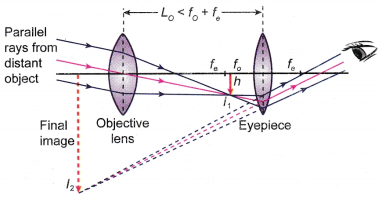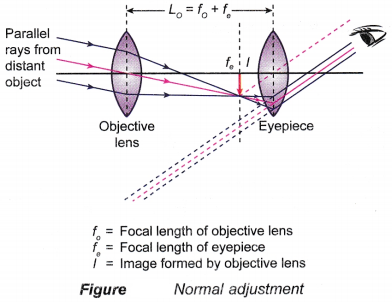The Uses of Lenses in Optical Devices
Simple Microscope

- A magnifying glass is the simplest microscope. It consists of a single convex lens with short focal length.
- When the magnifying glass is held near to the eye and the object is placed inside its focal length (u < f), a virtual, magnified and upright image is produced.
- A sharper and larger image is seen at the near point.
- In general, the near point is taken as 25 cm. This is the closest distance at which an object/image can be brought into focus by the eye.
People also ask
- What is a Lens?
- What is the thin lens equation?
- Lens Formula & Magnification – Lens Power
- What are the Types of Spherical Lenses
- Image Formation By Concave And Convex Lenses
- To Construct Optical Devices Using Lenses
Compound Microscope

- A compound microscope is an optical instrument used to view near and very small objects. It is made up of two powerful convex lenses, the objective lens and the eyepiece, of short focal lengths ranging from 5.0 cm to 10.0 cm.
- The objective lens is the lens nearer to the object. The more powerful lens or the lens with a shorter focal length is used as the objective lens.
- The objective lens is used to produce a real, inverted and magnified image, I1.
- The object to be observed must be placed between F0 and 2F0 of the objective lens.
- The eyepiece functions as a magnifying glass. It is used to magnify the first image, formed by the objective lens.
- The eyepiece must be positioned so that the first image, I1 is between the lens and the focal point of the eyepiece, Fe.
- In normal adjustment, the combination of the two lenses of the microscope produces a final image, I2 which is inverted with respect to the object, O.
- The final image, I2 formed by the eyepiece, is virtual, inverted with respect to the object, O and magnified.
- The final image, I2 will be at the near point, about 25 cm from the eye.
- In normal adjustment, the distance between the lenses is greater than the sum of their focal lengths, L0 > f0 + fe.
- If the height of the object is h0, the height of the image, I1 is h1 and the height of the final image, I2 is h2, then the magnification produced by the objective lens is:
 and the magnification produced by the eyepiece is:
and the magnification produced by the eyepiece is:

- The magnification of a compound microscope is:

Astronomical Telescope

- An astronomical telescope is an optical instrument used to view distant objects. It is made up of two convex lenses, the objective lens and the eyepiece.
- The objective lens has a low power (long focal length) whereas the eyepiece has a high power (short focal length).
- The objective lens converges the parallel rays from a distant object and forms a real, inverted and diminished image, I1 at its focal point, F0.
- The eyepiece functions as a magnifying glass. It is used to produce a virtual, upright and magnified image, I2.
- When the telescope is used in normal adjustment, the final image is produced at infinity as shown in Figure.

- This is done by adjusting the position of the eyepiece so that the image formed by the objective lens, I becomes the object at the focal point, Fe of the eyepiece.
- In normal adjustment, the distance between the lenses is equal to the sum of their individual focal lengths, L = f0 + fe.
- The magnification of the telescope in normal adjustment is given by:

Differences and similarities between a compound microscope and an astronomical telescope
| Compound microscope | Astronomical telescope |
| Consists of two high powered convex lenses (+20 D and +14 D). | Consists of a high powered (+14 D) and a low powered (+2 D) convex lenses. |
| The focal length of the objective lens is shorter than the focal length of the eyepiece (f0 < fe). | The focal length of the objective lens is longer than the focal length of the eyepiece (f0 > fe). |
| Image formed by the objective lens is magnified. | Image formed by the objective lens is diminished. |
| In normal adjustment, the final image is at the near point. | In normal adjustment, the final image is at infinity. |
| Distance between the objective lens and the eyepiece: L0 > f0 + fe | Distance between the objective lens and the eyepiece: L0 ≤ f0 + fe |
Similarities:
| |
Single-lens Camera

- A typical camera consists of a light-proof box with a convex lens mounted at the front and a roll of film placed at the back.
- The basic structure of a camera is shown in Figure. It consists of a convex lens, a film, a shutter and a diaphragm.
- The convex lens is used to produce a real and inverted (and usually diminished) image on a light-sensitive film placed at the back of the camera.
- The focusing screw is used to focus the image on the film.
- For a distant object, the image is formed near the focal point, F. The focusing screw is adjusted to move the focal point, F towards the film so as to get a sharp image on the film.
- For a near object, the image is formed at a distance greater than the focal length of the lens. The focusing screw is adjusted to move the focal point, F away from the film in order to obtain a sharp image on the film.
- The diaphragm is used to adjust the size of the aperture, which controls the amount of light entering the camera. The actual function of the aperture is to control the depth of field.
- The shutter controls whether light is allowed to reach the film or not. The speed of the opening and closing of the shutter is used to control the exposure time when taking a photograph.
Slide Projector

- A slide projector is a device used to view photographic slides. It has four main parts, a projection lamp, a concave reflector, a condensing lens and a projector lens.
- When light from the projection lamp passes through the slide and projector lens, the resulting image is enlarged and projected onto a perpendicular flat screen where the audience can view the reflection of the slide.
- The slide being the object, is placed between f and 2f from the projector lens, where f is the focal length of the projector lens. The image formed on the screen is real, inverted and magnified.
- For an image of higher magnification to be formed on the screen, the slide is placed closer to f and the screen is placed further.
- The projection lamp is placed at the centre of curvature, C of the concave reflector so that all the light towards the reflector can be reflected back to the same path of the condenser lens. The condenser lens consists of two plano-convex lenses separated by a heat filter. The heat filter is to protect the slide from being overheated by the lamp.
- The projection lamp is also placed at the focal point of the condenser lens. The direct light from the lamp and the reflected light from the concave reflector spread out evenly over the surface of the slide after passing through the condenser lens.
- The movable projector lens focuses a sharp, inverted and magnified image onto a screen.
- The slide has to be placed upside down in order to form an upright image on the screen.